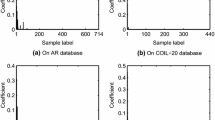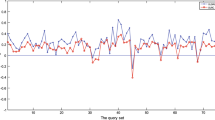Abstract
Non-negativity is a critical and explainable property in linear representation-based methods leading to promising performances in the pattern classification field. Based on the non-negativity, a powerful linear representation-based classifier was proposed, namely non-negative representation-based classifier (NRC). With the non-negativity constraint, the NRC enhances the power of the homogeneous samples in the linear representation, while suppressing the representation of the heterogeneous samples, since the homogeneous samples tend to have a positive correlation with the test sample. However, the NRC performs the non-negative representation on the original feature space instead of the high-dimensional non-linear feature space, where it is usually considered when the data samples are not separable with each other. This leads to the poor performance of NRC, especially on high-dimensional data like images. In this paper, we proposed a Kernel Non-negative Representation-based Classifier (KNRC) for addressing this problem to achieve better results in pattern classification. Furthermore, we extended the KNRC to a dimensionality reduction version to reduce the dimensions of the KNRC’s feature space as well as improve its classification ability. We provide extensive numerical experiments including analysis and comparisons on 12 datasets (8 UCI datasets and 4 image datasets) to validate the state-of-the-art performance obtained by the proposed method.











Similar content being viewed by others
References
Akhtar N, Shafait F, Mian A (2017) Efficient classification with sparsity augmented collaborative representation. Pattern Recogn 65:136–145
Anava O, Levy KY (2016) k*-nearest neighbors: From global to local. In: Proceedings of the 30th international conference on neural information processing systems, pp 4923–4931
Bengio Y, Delalleau O, Le Roux N (2005) The curse of dimensionality for local kernel machines. Techn Rep 1258:12
Boyd S, Boyd SP, Vandenberghe L (2004) Convex optimization. Cambridge University Press, Cambridge
Boyd S, Parikh N, Chu E (2011) Distributed optimization and statistical learning via the alternating direction method of multipliers. Now Publishers Inc
Cai S, Zhang L, Zuo W, Feng X (2016) A probabilistic collaborative representation based approach for pattern classification. In: Proceedings of the IEEE conference on computer vision and pattern recognition, pp 2950–2959
Chen L, Man H, Nefian AV (2005) Face recognition based on multi-class mapping of fisher scores. Pattern Recogn 38(6):799–811
Cortes C, Vapnik V (1995) Support-vector networks. Machine Learn 20(3):273–297
Du L, Zhou P, Shi L, Wang H, Fan M, Wang W, Shen YD (2015) Robust multiple kernel k-means using l21-norm. In: Twenty-fourth international joint conference on artificial intelligence
Dua D, Graff C (2017) UCI machine learning repository. http://archive.ics.uci.edu/ml
Duda RO, Hart PE, Stork DG (2012) Pattern classification. John Wiley & Sons, New York
He K, Zhang X, Ren S, Sun J (2016) Deep residual learning for image recognition. In: Proceedings of the IEEE conference on computer vision and pattern recognition, pp 770–778
Hosseini B, Hammer B (2018) Confident kernel sparse coding and dictionary learning. In: 2018 IEEE International conference on data mining (ICDM), pp 1031–1036. IEEE
Hosseini B, Hülsmann F., Botsch M, Hammer B (2016) Non-negative kernel sparse coding for the classification of motion data. In: International conference on artificial neural networks. European Neural Network Society
Hoyer PO (2002) Non-negative sparse coding. In: Proceedings of the 12th IEEE workshop on neural networks for signal processing, pp 557–565. IEEE
Hussain SF (2019) A novel robust kernel for classifying high-dimensional data using support vector machines. Expert Syst Appl 131:116–131
Lee DD, Seung HS (1999) Learning the parts of objects by non-negative matrix factorization. Nature 401(6755):788–791
Liang J, Qin Z, Xiao S, Ou L, Lin X (2019) Efficient and secure decision tree classification for cloud-assisted online diagnosis services. IEEE Transactions on Dependable and Secure Computing
Liu Y, Wei Y, Wang C (2019) Subcortical brain segmentation based on atlas registration and linearized kernel sparse representative classifier. IEEE Access 7:31547–31557
Mercer J (1909) Xvi. functions of positive and negative type, and their connection the theory of integral equations. Philosophical transactions of the royal society of London. Series A, Containing Papers of a Mathematical or Physical Character 209(441-458):415–446
Minaee S, Boykov YY, Porikli F, Plaza AJ, Kehtarnavaz N, Terzopoulos D (2021) Image segmentation using deep learning: A survey IEEE transactions on pattern analysis and machine intelligence
Nene SA, Nayar SK, Murase H, et al. (1996) Columbia object image library (coil-100)
Ren M, Zeng W, Yang B, Urtasun R (2018) Learning to reweight examples for robust deep learning. In: International conference on machine learning, pp 4334–4343. PMLR
Shawe-Taylor J, Cristianini N, et al. (2004) Kernel methods for pattern analysis. Cambridge University Press, Cambridge
Shen T, Ott M, Auli M, Ranzato M (2019) Mixture models for diverse machine translation: Tricks of the trade. In: International conference on machine learning, pp 5719–5728. PMLR
Śmieja M, Struski Ł, Tabor J, Marzec M (2019) Generalized rbf kernel for incomplete data. Knowl Based Syst 173:150–162
Szegedy C, Liu W, Jia Y, Sermanet P, Reed S, Anguelov D, Erhan D, Vanhoucke V, Rabinovich A (2015) Going deeper with convolutions. In: Proceedings of the IEEE conference on computer vision and pattern recognition, pp 1–9
Theodoridis S, Koutroumbas K (2009) Chapter 4 - nonlinear classifiers. In: Pattern Recognition (Fourth Edition). fourth edition edn. https://doi.org/10.1016/B978-1-59749-272-0.50006-2. Academic Press, Boston, pp 151–260
Thomaz CE, Giraldi GA (2010) A new ranking method for principal components analysis and its application to face image analysis. Image Vis Comput 28(6):902–913
Timofte R, Van Gool L (2014) Adaptive and weighted collaborative representations for image classification. Pattern Recogn Lett 43:127–135
Varikuti DP, Genon S, Sotiras A, Schwender H, Hoffstaedter F, Patil KR, Jockwitz C, Caspers S, Moebus S, Amunts K et al (2018) Evaluation of non-negative matrix factorization of grey matter in age prediction. Neuroimage 173:394–410
Vert JP, Tsuda K, Schölkopf B (2004) A primer on kernel methods. Kernel Methods Comput Biol 47:35–70
Vinge R, McKelvey T (2019) Understanding support vector machines with polynomial kernels. In: 2019 27th European signal processing conference (EUSIPCO), pp 1–5. IEEE
Wang N, Wang J, Yeung DY (2013) Online robust non-negative dictionary learning for visual tracking. In: Proceedings of the IEEE international conference on computer vision, pp 657–664
Wright J, Ma Y, Mairal J, Sapiro G, Huang TS, Yan S (2010) Sparse representation for computer vision and pattern recognition. Proc IEEE 98(6):1031–1044
Wright J, Yang AY, Ganesh A, Sastry SS, Ma Y (2008) Robust face recognition via sparse representation. IEEE Trans Patt Analy Mach Intell 31(2):210–227
Wu SG, Bao FS, Xu EY, Wang YX, Chang YF, Xiang QL (2007) A leaf recognition algorithm for plant classification using probabilistic neural network. In: 2007 IEEE international symposium on signal processing and information technology, pp 11–16. IEEE
Xie Y, Liu J, Qu Y, Tao D, Zhang W, Dai L, Ma L (2020) Robust kernelized multiview self-representation for subspace clustering. IEEE transactions on neural networks and learning systems
Xu J, An W, Zhang L, Zhang D (2019) Sparse, collaborative, or nonnegative representation: which helps pattern classification? Pattern Recogn 88:679–688
Xu Y, Zhu Q, Fan Z, Zhang D, Mi J, Lai Z (2013) Using the idea of the sparse representation to perform coarse-to-fine face recognition. Inf Sci 238:138–148
Zeng S, Yang X, Gou J (2017) Multiplication fusion of sparse and collaborative representation for robust face recognition. Multimed Tools Appl 76(20):20889–20907
Zeng S, Zhang B, Gou J, Xu Y (2020) Regularization on augmented data to diversify sparse representation for robust image classification. IEEE Transactions on Cybernetics
Zeng S, Zhang B, Zhang Y, Gou J (2018) Collaboratively weighting deep and classic representation via l_2 regularization for image classification. In: Asian conference on machine learning, pp 502–517. PMLR
Zeng S, Zhang B, Zhang Y, Gou J (2020) Dual sparse learning via data augmentation for robust facial image classification. Int J Mach Learn Cybern 1717–1734
Zhang L, Yang M, Feng X (2011) Sparse representation or collaborative representation: Which helps face recognition?. In: 2011 International conference on computer vision, pp 471–478. IEEE
Zhang L, Zhou WD, Chang PC, Liu J, Yan Z, Wang T, Li FZ (2011) Kernel sparse representation-based classifier. IEEE Trans Signal Process 60(4):1684–1695
Zhang Y, Xu T, Ma J (2017) Image categorization using non-negative kernel sparse representation. Neurocomputing 269:21–28
Zhou J, Zeng S, Zhang B (2020) Linear representation-based methods for image classification: A survey. IEEE Access 8:216645–216670
Zhou J, Zeng S, Zhang B (2020) Two-stage knowledge transfer framework for image classification. Pattern Recogn 107:107529
Zhu R, Dong M, Xue JH (2019) Learning distance to subspace for the nearest subspace methods in high-dimensional data classification. Inform Sci 481:69–80
Acknowledgements
This document is the result of a research project funded by the University of Macau (File no. MYRG2019-00006-FST).
Author information
Authors and Affiliations
Corresponding author
Ethics declarations
Conflict of Interests
The authors declare that they have no conflict of interest.
Additional information
Publisher’s note
Springer Nature remains neutral with regard to jurisdictional claims in published maps and institutional affiliations.
Rights and permissions
About this article
Cite this article
Zhou, J., Zeng, S. & Zhang, B. Kernel nonnegative representation-based classifier. Appl Intell 52, 2269–2289 (2022). https://doi.org/10.1007/s10489-021-02486-0
Accepted:
Published:
Issue Date:
DOI: https://doi.org/10.1007/s10489-021-02486-0




